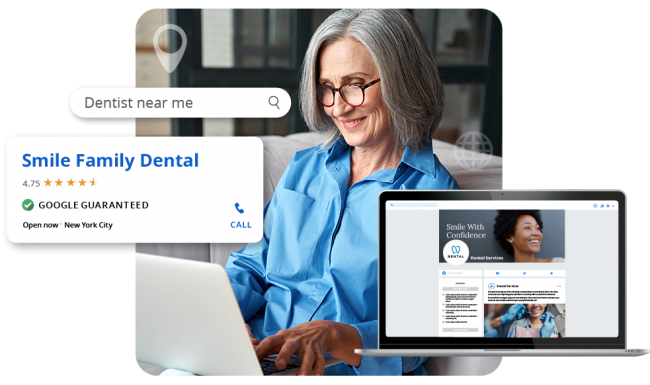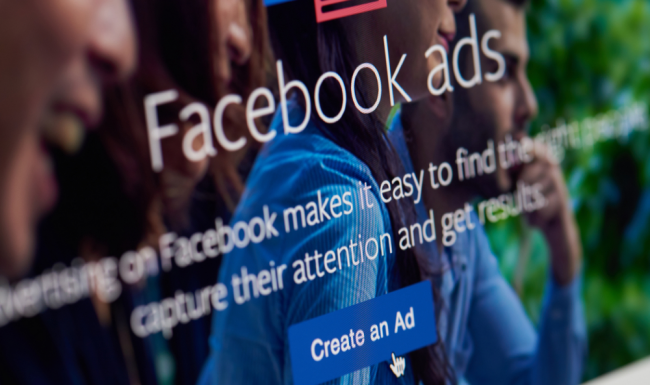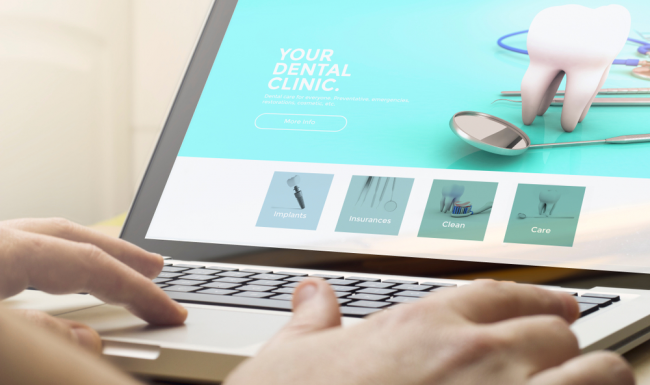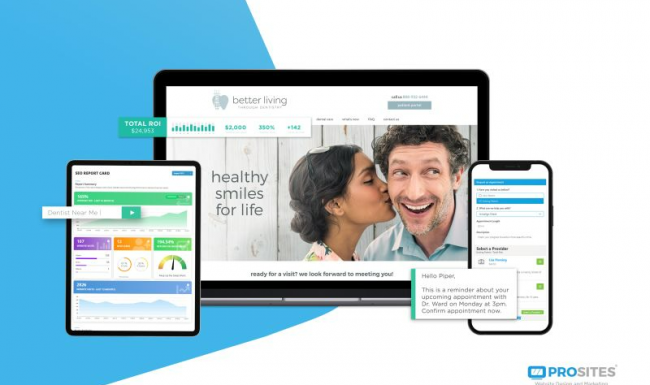Looking to increase your patient base through dental ads? If so, you’re in good company. According to our 2023 State of Dental Marketing report, 26% of surveyed dental practices are planning more dental ads on social media, and roughly half of surveyed practices will use more PPC dental ads, less, or the same amount to help attract more website traffic and keep their dental chairs full.
Overall, our report shows 74% of dental practices are planning to increase their marketing budgets in 2023 or keep them the same. The specific activities they plan on pursuing (from upgrading their websites and cultivating more online patient reviews to SEO and organic social posts) all fall under the umbrella title of dental advertising, meaning public communications that promotes a product, service, or brand. So, in this guide, we use the phrase “dental ads” in the general sense to cover a variety of ways to market your dental practice more effectively and get more patients.
What Is Dental Advertising?

Though some dental practices tend to view dental ads more as effective tools to acquire new patients, this is only half of the equation. Dental ads are equally effective to strengthen client relationships and retain patients, which may sound counterintuitive to revenue growth. Yet as we detail in the next section, using dental ads to simply retain more patients can significantly contribute to revenue growth.
Before we get to that, though, we’ll acknowledge something. Phrases like “acquire new patients” and “retain more patients” are broad, vague phrases that naturally beg the question, “How do dental ads specifically accomplish this?”
The answer begins by better understanding the specific benefits of dental ads, because specific benefits naturally relate to the specific goals that your dental practice wishes to reach, and the how-to mechanisms that will take you there.
What Are Specific Benefits of Dental Advertising?

Though we’ve compartmentalized specific benefits of dental ads for clarity and ease of understanding, there’s something important to keep in mind as you go through this guide.
Individual dental marketing mechanisms like social media management or video marketing can certainly help your dental practice reach certain goals through the specific benefits attached to them. Yet just as different dental procedures and practices work together to support the whole of a patient’s oral health, individual marketing mechanisms working together typically result in marketing returns greater than the sum of any individual part.
Pay-per-click ads (PPC) and practice websites provide an illustration. Practices can (and do) generate more traffic to their websites by using PPC advertising to get in front of more prospective patients. Yet if those prospective patients encounter an outdated website that doesn’t instill confidence or serve them, they’re quickly going to bounce. Inversely, a practice can have an attractive, professional website that instantly elicits trust and converts. Yet if a practice can’t get in front of more prospective patients through PPC or another mechanism, their website cannot work as well as it could to land more new patients and grow practice revenue.
The importance of marketing mechanisms working together partly explains why priorities and marketing budgets are now shifting for dental practices, reflected in our 2023 State of Dental Marketing report:
- Websites, online reviews, and social media are all trending upward in importance for dental practices
- Almost 70% of surveyed practices are planning more SEO to improve website discovery
- Almost half of practices (45%) are planning more organic social media posts
- Over a quarter of surveyed practices (26%) are planning more social media advertising
- Roughly the same number (27%) are planning to cultivate more online patient reviews
With this mind, here are specific benefits of dental ads:
Increased brand/practice awareness
If prospective patients don’t know about your dental practice, you naturally miss out on new patient opportunities, and yes. Word-of-mouth advertising can certainly expand awareness of your dental practice and will remain important. Yet in an increasingly online world, word of mouth can only have limited reach, which is why only 25% of surveyed practices in our 2023 State of Dental Marketing report now consider word-of-mouth advertising important, versus 80% from just one year earlier.
Increased website traffic through awareness
According to 2022 research by HubSpot, 4 out of 5 people use search engines to find local information, and when they do, they naturally click on top search results to visit business websites, and website traffic generated from search engine results pages can be considerable. According to BrightEdge Research, Google drives 8 times more traffic than social media, and more traffic to your dental practice website naturally means increased awareness and opportunity to convert more visitors into patients.
Increased practice credibility
Dental ads in the form of online patient reviews are a key form of dental advertising because they build trust and help convert more prospective patients through social proof. According to BrightLocal, 79% of people trust online reviews as much as personal recommendations, especially when reviews are current. Almost 90% of people do not look at reviews older than three months, and 50% of people require either 4-6 or 7-10 online reviews before trusting a business. Such findings explain why over a quarter of dental practices (27%) are planning to cultivate more online patient reviews, detailed in our free 2023 State of Dental Marketing report.
Increased website conversion rate
Realizing the benefit of increased website conversion rates involves having key elements in place for visitors when they reach your practice website through dental ads:
- Visual Appeal
According to Stanford University studies, the overall look of a website is the top factor related to perceived trust and credibility by website visitors, which is why ResearchGate recently said, “Companies that design for trust have a strategic advantage over competitors.” Here are examples of dental websites designed for trust and credibility.
- Easy Navigation
Prospective patients don’t want to hunt around for information about who you are and the services you offer. Prospective patients want easy, intuitive website navigation.
- Recent, Relevant Content
Your website content (from your About Us section to news updates and blogs) colors the whole of a prospective patient’s perception of your dental practice. If information is old, for example, prospective patients may view your practice as out of touch or question credibility. As Relevant Insights recently reported, “People assign more credibility to sites that show they have been recently updated or reviewed.”
Increased Social Media Following
The dental industry hasn’t historically been as active on social media as other industries. Yet 76% of surveyed practices in our 2023 State of Dental Marketing report are planning to be more active on social media in 2023 and beyond. Practices have come to understand that maintaining a consistent presence on social media builds followers, drives new leads, and keeps current patients engaged to keep dental chairs full, and practices active on social media are certainly reaching toward a large audience. In January 2023, the number of social media users worldwide reached 4.76 billion (or roughly half the global population), and Statista projects there will be nearly 6 billion users worldwide by 2027.
Increased Patient Satisfaction
Dental ads help increase patient satisfaction (and thereby retention) when they take the form of evidence by what you do or provide.
By providing online patient forms and online payments, for example, you show patients that you care about making their lives easier, and you save time and increase efficiency for your practice in the process. Similarly, when dental ads take the form of patient satisfaction surveys that ask the right questions, you show patients that you value their feedback and want to ensure they’re receiving the best patient experience possible.
“Patients will have a positive experience when they feel we understand and meet their needs,” writes Oral Health Group, “that we are doing things in their best interest, and we respect and appreciate them.”
What Are the Steps to Advertise Your Dental Practice?

Step 1: Identify Your Target Audience
The more you know about your target audience, the more effective dental ads become. Facebook ads, for example, enable you to laser target specific audiences based on geographic location, age, job title, specific interests, or other demographic information.
Step 2: Create a List of Dentists and Dental Practices That Target Your Audience
In any business, understanding the competition is foundational to effective marketing. In a competitive dental market, patients visit competing practices for a reason, and that reason may be something as simple as geographic location. Yet it may be something more. Perhaps competitors offer certain services or pricing that stands as a differentiator. To attract more patients through dental ads, list competing practices in your area. Examine what they offer and how they present themselves, then consider what makes your practice unique to identify your practice differentiator.
Step 3: Plan and Run Timely and Relevant Ads
Certain oral health care subjects will always be of interest to patients. Yet other subjects are timely. A simple example: Running dental ads in December that remind patients to use up dental benefits before the end of the year are naturally better timed and relevant than running such ads in summer. Dental ads are a combination of subject matter and timing.
Step 4: Use Optimized Landing Pages
A landing page on your dental website is a page that highlights something in detail (e.g., your services). It’s a congruent extension of a dental ads where patients “land” after clicking on a dental ad and represents the completion of a desired action, such as “Click here to make an appointment. The fundamentals of an optimized dental landing page include a compelling headline, concise copy, social proof (e.g., testimonials), insurance information, and a clear call to action.
Overall, a landing page should instantly answer three primary questions in the mind of a prospective patient: “Where am I, did I come to the right place, and what can I do here?”
Step 5: Run Ads That Are Visually Appealing
This may be obvious, but it bears repeating. Attractive images tend to attract prospective patients. Poor-quality images tend to drive them away. So, carefully select good-quality images when creating dental ads. Along with this, cohesion is the guiding principle in dental ads. If your practice website, for example, has a somewhat formal look, other dental ad images should have a similar look and tone. Inversely, if your practice website has an informal look, other dental ad images should follow suit.
Step 6: Use Keywords and Phrases
Though this applies to dental SEO for improved website discovery through search engines, it now also applies to social media. More people now use social media than they did a few years ago. A recent internal study by Google found that 40% of 18- to 24-year-olds now prefer using social media as their primary search engine to find information on brands, services, and products, rather than scrolling through a long list of Google results, meaning dental ads with keywords on social help improve post discovery.
Step 7: Create Video Ad Campaigns
Short-form video accounted for more than half of the time spent by users on social in 2022, according to Insider Intelligence, and short-form video has the highest ROI of any social media marketing. This explains why 71% of dental practices are actively investing in video ad campaigns to round out their marketing efforts and dental ads.
Step 8: Don’t Neglect Remarketing Strategies
Remarketing (a.k.a. retargeting) refers to dental ads directed toward people who are already patients or have expressed interest in your dental practice.
Step 9: Measure Dental Ad Success
Monitor the metrics of your dental ads to gauge how they’re performing and adjust your dental ads as needed to keep your objectives on target.
Step 10: Ensure Your Dental Practice Has the Right Tools to Manage It All
There’s a reason why 58% of dental practices now use an online marketing provider (up from 38% in 2022). Dental ads can (and do) fill dental chairs for practices and increase ROI, but managing dental ads takes time. That’s why practices choose online marketing providers like ProSites.
Trusted by over 7,500 dental practices and endorsed by 15 state dental associations, ProSites helps practices realize measurable ROI with a comprehensive suite of solutions, including custom websites, SEO, video marketing, social media management, Facebook ads, and more.
>> Visit ProSites for more info
15 Tips on How to Get More Patients Through Dental Advertising

- Develop a brand identity and be consistent with that identity in dental ads.
- Utilize social media platforms that are appropriate for your brand and are aligned with your target audience.
- Write effective ad copy that uses clear, concise, uncomplicated language.
- Use effective images, meaning good-quality images that reflect your brand and are relevant to your dental ads.
- Be consistent with your brand so you’re quickly recognizable to patients and prospects in whatever form your dental ads take.
- Target specific audiences for more focused dental ads.
- Utilize search engine optimization to rank higher in search engines and improve online discovery.
- Utilize email marketing, which remains effective by its direct nature.
- Try guerilla marketing techniques, meaning innovative, low-cost marketing techniques aimed at maximum exposure for your practice.
- Utilize outside advertising spaces where budget allows and where outside advertising makes sense in relation to your target audience.
- Make use of locality marketing, meaning local marketing that targets prospective patients within a certain radius of your practice’s physical location.
- Invest in Google Ads and a Google Business Profile.
- Utilize Yelp advertising to reach prospective patients searching for dental practice reviews.
- Participate in trade shows and events.
- Keep track of your campaign results and adjust your dental ads accordingly to keep your goals on target.
In Summary
As you’ve likely gathered from the data presented, dental practices are now investing in many different forms of dental ads, and this makes complete sense because yes, individual forms of dental ads can perform well on their own. Yet when combined, dental ads work better for your practice because they support each other and increase overall effectiveness in a competitive dental market, which is why dental practices choose ProSites.




